Light and Truth: Greener Interiors with Glass Partitions
Innovative applications for modular glass partitions, room dividers and doors provide effective pathways to modern interior trends.
![]() Continuing Education
Continuing Education
Use the following learning objectives to focus your study while reading this month’s Continuing Education article.
Learning Objectives - After reading this article, you will be able to:
- Discuss the general applications of glass interior partitions and glass sliding doors in contemporary architecture in functional terms.
- Describe trends in sustainability and universal design that affect the selection of glass interior partitions and glass sliding doors.
- List methods for specifying glass interior partitions and glass sliding doors for healthy building occupants and increased daylight and views.
- Apply trends in green building, including new green codes and standards for interior furnishings and finishes, to the specification of glass interior partitions and sliding doors.
The popularity of glass interior partitions, made of aluminum or other metal frames and glass panels, is borne out by their increasing use and availability – albeit in low-quality versions – at do-it-yourself stores. The higher-end, original sliding doors and movable framed-glass walls are familiar to all architects, seen in offices and other settings since the 1960s, when progressive organizations like the ad agency Sterling Cooper depicted in Mad Men used the decidedly modern, industrialized wall systems.
To quote the ad refrain from back in the day, they’ve come a long way, baby. Today, the glass partitions are seen not only in commercial office interiors but also in multi-unit residential projects such as condominiums and rental lofts, as well as hotel rooms and even along corridors in schoolrooms and laboratories. “The fact is, the products are extremely diverse, and can be used in virtually all types of settings,” says Todd Schwartz, commercial sales manager at The Sliding Door Company.
The main reasons? Glass walls and glass sliding doors are seen as space-savers, maximizing the value of real estate. They can also improve the flexibility of open spaces, another significant benefit.
Even seemingly unrelated trends such as green building, flexible work styles and recent economic challenges have led to more use of glass sliding partitions in workplace design. “Green building favors modular, flexible interior systems as well as more exposure to windows and views,” says Andrew Franz, AIA, an architect and principal of Andrew Franz Architect PLLC, New York City. “In office buildings, many companies that are growing or shifting focus don’t necessarily want to throw everything out every time they move or restack the workplace. They want to take their investments with them.”
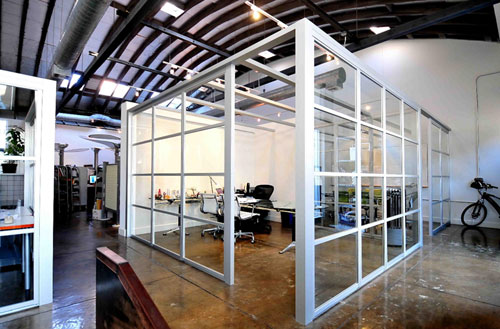 |
Modular interior partition systems can be used without doors to demarcate space and create privacy. |
For that reason, portable office elements such as “knockdown storefront systems” are even more appealing, says Franz, because they can be dismantled and moved to the next space. This dovetails nicely with the U.S. Green Building Council’s LEED certification program and other standards, such as the International Green Construction Code (IGCC), which reward the use of demountable, moveable building systems as well as interior glass panels. In addition, there are opportunities for improved project scheduling and staging that may be advantageous. Last, the wall systems – like furniture – can be depreciated more rapidly, a benefit at tax time.
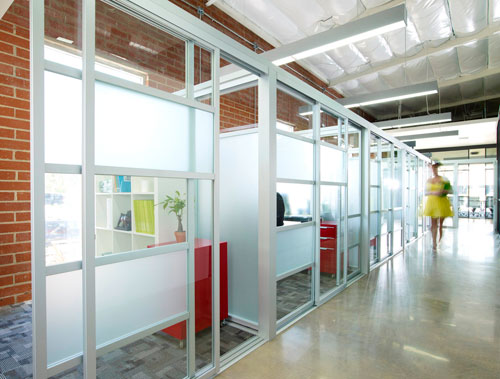 |
The use of consecutive partitions appear as an interior storefront system, yet can still be dismantled and moved to another building or space. LEED and IGCC certifications may offer credits for using demountable, moveable building systems as well as interior glass panels. |
The value of using prefabricated glass walls and sliding doors has migrated to multifamily and hotel room interiors, where they help open up the spaces, bring in daylight and views, while still providing privacy and acoustical separation.
| Construction and ROI: More Benefits for Glass Partition Systems |
||||||||||||||||
Glass partition systems with sliding doors visually open up building interiors, giving more building occupants exposure to windows and view. Other benefits drop to the bottom line, providing quantifiable return on investment (ROI):
|
The inner glass envelope
More than anything else, glass walls bring the opportunity for layered spatial programming relative to the building envelope. This means that a glass partition layer may be introduced inboard of the perimeter walls, to provide a new use area without reducing daylight penetration or views to outdoors.
The result – an inner glass envelope, so to speak – is one of the architectural and space-planning trends of contemporary architecture. Office buildings increasingly feature an open-plan work area at the building perimeter, lined by glass-fronted enclosed offices that may back up to the circulation core. In hotel guestrooms and multifamily units, often the unit layout is a narrow, deep volume with one or more end-windows at the perimeter. Using glass partitions, daylight from the perimeter area carries deeper into the volume, toward the center of the building. Shared areas may enjoy proximity to windows while bedrooms, kitchens and even bathrooms sit behind glass walls, private and separate yet united by sunlight and view.
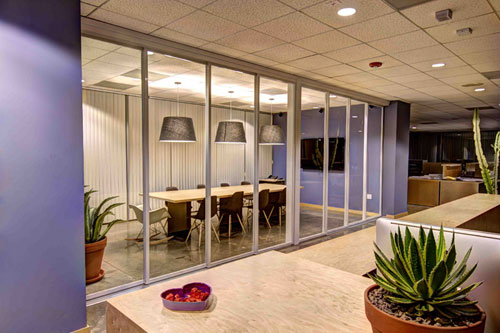 |
Sliding door assemblies on the modular glass-and-aluminum partition systems can be either a bottom floor-track rolling systems or top-hung suspended doors. |
Other building types can also benefit from this, such as buildings where a “sterile corridor” or separated viewpath needs visual access to other building activities. Examples include laboratories, schools, and industrial settings.
Specifying glass interior partitions
While these layouts and capabilities are favored, there are many facets to the architect’s goal of opening and enlivening interior spaces. Properly designing and specifying the glass partitions and glass sliding doors is one of the key challenges.
When it comes to modular glass partition systems, the focus is on creating a robust, elegant wall that holds its value while performing properly. “Where durability matters, the commodity products sold at big-box stores are simply not up to the task,” says Schwartz. “Part of product selection is determining whether the system is suited to the use and the life cycle of the project.”
Application analysis. For projects using movable and demountable walls, architects need to analyze anticipated uses and the best options for flexibility. Doors and wall panels can be opened to let in light and air, or they can be closed for privacy. They can be integral to a total home design or commercial space plan to make the best use of large spaces.
Metal-framed glass walls can also be used to divide areas into new rooms, such as in lofts or other open-plan interiors, enhancing functionality. Workspaces created from sliding glass doors can provide flexibility for shared workplaces, satellite offices, as well as group conference nodes. Glass sliding doors create a larger sense of space and can be used in daylight harvesting strategies for greater access to views of nature.
These modular components replace traditional drywall partitions and other construction types that are less flexible, promoting change. Some typical applications and benefits include:
- Daylight harvesting.
- Maximizing space in small rooms.
- Modernization or rebranding of a business.
- Cost-effective upgrading or “refreshing” of the property’s image, for example at hotels, restaurants or offices where the changes are often needed every five to seven years.
- Instituting new workplace models to allow for more collaborative work, flexible work schedules or coworking, where individuals and groups office together even though they work on different projects or for different employers.
- Improving interior environmental quality (IEQ), to meet tenant and employee expectations for healthier air quality, increased access to daylight, reduced toxicity of materials and finishes, and flexibility of work and living space configurations.
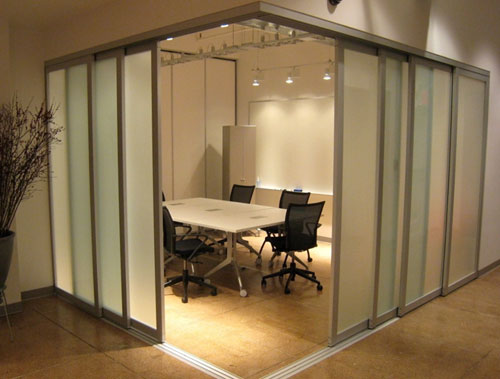 |
To accommodate new workplace needs, such as increased collaboration space or flexible meeting space, modular glass partitions offer flexibility and ease of installation. |
Durability and life-cycle assessment. The durability of any selected product should be considered against the expected use. The new LEED credit – Life Cycle Assessment of Building Assemblies and Materials – is available for new construction and healthcare projects, using the Athena Institute’s EcoCalculator to calculate and compare the environmental impacts of various material assemblies, as well as the USGBC LEED Credit Calculator, which creates LCA Impact Scores and generates LEED Credits for the design under consideration.
For glass wall partitions, room dividers, closet doors and wall-slide doors (an alternative to the common pocket door), the selected products and assemblies should be reviewed with the following criteria in mind:
- Source: Glass wall systems sold through mass-market channels, such as big-box retailers, should be checked to ensure they are commercial grade; many are not. It is also helpful to compare local and national suppliers, as some prefab systems – even if shipped from overseas – may be more cost-effective than systems provided by local fabricators.
- Materials: Doors or partitions should be constructed with a sturdy aluminum frame and gliding mechanisms that assure the movable panels will not leave the tracks.
- Lead time: Some products may have long lead-time due to the various design options and types of sliding hardware used.
In general, two types of sliding door assemblies are used: a bottom floor-track rolling system, and top-hung suspended doors. Price points vary between the system types. The bottom-track systems are favored by some architects because they can eliminate some safety and liability issues. Another recent innovation is a sliding clamp device that prevents sliding doors from leaving their tracks. Known as wheel-to-track locking mechanisms, these proprietary hardware features help secure panels within the track system.
Panel safety mechanisms vary depending on the manufacturer and product design. Assemblies sourced from European manufacturers should be reviewed, as different product safety laws may allow systems without panel safety mechanisms. In all cases, safety features may be incorporated into the LCA study, with attention to reduced liability as well as occupant injuries. In addition to reducing hazards associated with hardware and door operation, the architect may review glass safety issues.
Glass selection and specification. Modular metal and glass walls as well as knockdown storefront systems need suitable hardware and frames, but the glass choice is just as critical.Finishes and coatings, as well as glass safety design, are all considered in the specification.
In terms of performance and safety, tempered glass is typical for the interior applications – but not all suppliers offer it. Some manufacturers supply 5mm-thick as a standard offering for the walls and doors, while others employ 3mm or 4mm glass, some without tempering. As an option, some applications may benefit from using 7mm-thick laminated glass panels.
The desired look and anticipated use of the assemblies drives other aspects of the spec; glass finish options include clear, frosted, or a combination of both. Other visual options include opaque panels and novel glass textures such as “linen” or “smoked” surfaces.
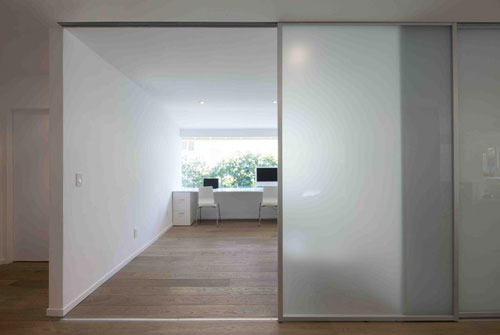 |
In terms of structural approach, the modular partitions and sliding glass walls may be hung by their aluminum or steel frame from the ceiling or they can be supported from the floor. Door and fixed panel weights vary, but typically run from about 35 pounds to up to 70 pounds or more for a door section of aluminum and tempered glass. |
| Applications and Options for Modular Glass Partitions |
RESIDENTIAL – Apartments & Condominiums COMMERCIAL – Office, Hospitality & More Freestanding Systems Frame Finishes |
Partition and divider types. The panel system itself has multiple options to consider. For example, the structural approach may be to hang the aluminum or steel frame from the ceiling or to support it from the floor. Door and fixed panel weights vary, but typically run from about 35 pounds to up to 70 pounds or more for a door section of aluminum and tempered glass. The location and size of the wall panels may be based on standard sizes and frame opening patterns, or the panels can be custom designed and built based on the architect’s design.
From full-height frames with no cross-membersto divided frames in various custom or prefabricated styles, the partitions allow the use of proportion, scale and other design considerations for a specific visual effect. Another technique is the use of support dividers, which separate glass sections so that, for example, the upper portions of a wall may have greater transparency to share daylight as needed.
Last, architects can select among a variety of door types, including sliding and swinging operable panels as well as fixed and stationary sections. Many manufacturers offer hardware and door construction that meets the standards and codes for room doors, closet doors and space dividers.
Size and scale. The system supplier or manufacturer should provide guidance on the maximum width and height for glass panels and for various operable sections, including swing, sliding and fixed-panel options. Standard widths are readily available, and range from 24 inches to 40 inches, for door heights of 80 inches or 96 inches. Using these standard dimensions, a large doorway or storage space, for example, may use three sliding sections of 24 inches each to enclose the opening.
Sliding closet doors are usually fit from floor to the top of the opening. If the opening height is greater than 9 feet or 10 feet, additional modular sections may be added as an upper tier of sliding or fixed panels. In all cases, the following should be considered:
- Swing doors must not exceed 40 inches in width.
- Closet doors and room dividers cannot exceed 120 inches height for some glass options.
- For room dividers, conference room partitions and the like, the maximum standard height may be about 120 inches.
- Panels that exceed 120 inches may require special shipping and handling, adding to the product cost.
Frame components, hardware and metal finishes. In addition to the dimension considerations above, modular glass-and-metal walls are also available with half-wall doors and full-wall doors. In both cases, the panel sections can be floor-mounted on a track assembly either (a) recessed and flush with the finished floor, or (b) with a surface-mounted track – typically about 3/8 inches high, meeting ADA requirements – with a ramp threshold intended to prevent tripping.
The second option, using the ramp assembly with a surface-mounted floor track, is beneficial for applications where frequent removal and reinstallations are anticipated. With this track option, reconfigurations and minor renovations can be handled by facilities personnel rather than specialized installers.
In all cases, the frame and gliding mechanisms should be detailed or specified carefully to ensure they are properly anchored and that moving parts stay in their tracks. According to the requirements of the Americans with Disabilities Act (ADA), all moving partitions and doors must have a calibrated push pressure of 5 lbs. or less.
 |
When specifying glass interior partitions, it is important that all frame and gliding mechanisms are detailed to remain properly anchored with all moving parts staying in their tracks. According to the ADA, all moving partitions and doors must have a calibrated push pressure of 5 lbs. or less. |
| An Early Use of Modular Partitions |
The much-studied use of modular office walls at the 1997 Robert L. Preger Intelligent Workplace at Carnegie Mellon University helped popularize the benefits of glass walls and sliding doors for workplace design. One goal of the workplace-interiors laboratory was to maximize the amount of available exterior window space for every inch of interior floor space. To do so, the creators of the space, Volker Hartkopf, director of Carnegie Mellon’s Center for Building Performance and Diagnostics, and architecture professor Vivian Loftness, specified sliding glass office doors so that daylight could penetrate the space into a central corridor. The modular office walls were designed for a partial-height design, which meant that ventilation air and outdoor air from operable windows could reach all interior spaces. For improved acoustics, the designers used baffles and other techniques to ensure privacy for the office workers. The workplace laboratory sits atop Margaret Morrison Carnegie Hall, a 100-year-old, neoclassical building on the college campus. “It's a living laboratory, continually being updated to feature advanced systems, components and materials,” according to the school. “And it's a lived-in laboratory, too — occupied by ‘real’ workers and organizations.” |
Last, glass panels and sliders are available with a variety of frame finishes. Attention to finish toxicity and off-gassing may be important to IEQ and related LEED credits. In most cases a sturdy frame of aluminum or another metal will be ideal for commercial or high-end residential applications.
Green building. Sliding partitions bring a number of environmental advantages to new construction and renovation projects. The systems are portable and demountable, and they can reduce waste and promote a variety of approaches to living and working. The systems are composed of primarily aluminum and glass, materials that are commonly recyclable at the end of the product’s useful life. Yet their reuse is perhaps the greatest advantage in terms of green building.
In addition to being 100 percent reusable, sliding door systems and glass framed partitions are modular, and so the systems can be removed and reused in the same location or in other like spaces. This versatility supports and encourages the adaptability of workplaces, for example, as facility managers adjust partition layouts and open or close sliding and rotating walls as needed.
“Sustainability is all about problem-solving that improves design in a cost-effective manner,” says Schwartz. “Prefabricated and modular systems allow for flexible configurations for growing businesses as well as businesses looking to downsize.”
Green building advocates favor maximum daylighting as long as it is glare-free and has no significant negative effect on building energy performance. In general, access to outdoor views and daylight have been shown to enhance worker well-being, mood and morale. Sunlight and views have an effect on reducing absenteeism and even increasing worker productivity, though quantifying those effects has been the subject of some debate. In all events, it is a primary credit for LEED projects in the IEQ categories.
More than that, opening up the interior visually means that daylight harvesting, the term for using building controls and active daylighting to reduce the need for artificial lighting and energy consumption. By carefully specifying the transparency of dividers and panels, the architect can control glare and allow privacy while maximizing the availability of natural light through the spaces. Less electrical light is needed, cutting costs and improving visibility, too.
In addition, glass-and-metal partitions are demountable and reusable or recyclable. They do not need to be painted and are factory finished to meet high indoor-air-quality standards. They generally have simple maintenance needs and do not require harsh chemicals for cleaning. Specified with low-VOC finishes to protect air quality, the systems can benefit IEQ beyond their benefits to daylighting and exterior views.
Accessibility and universal design. Recently, the USGBC has begun an initiative to incorporate universal design in to the LEED rating systems. The Pilot Credit 34, Design for Adaptability, provides points for homes and midrise construction that must meet the Fair Housing Amendments Act – those with four or more residential units and an elevator. To earn the credit, building designs must have at least twice the number of accessible units required by code. Universal design for midrise construction must include core dwelling spaces and living areas on the accessible level, as well as:
- A zero-step main entrance.
- Accessible entry doorways with a minimum clear width of 32 inches, with room for maneuvering both inside and outside the doorway.
- Accessible interior passage routes, with smooth, level floors and at least 36 inches of clear width to access building areas and living units.
- Adaptable bathrooms with minimum clear floor space of at least 30 inches by 48 inches and fixtures that meet ADA accessibility criteria.
- Accessible HVAC and lighting controls, located not lower than 15 inches from the floor and not higher than 48 inches.
The benefit of these features for sustainability is that by offering better access for all building users, the buildings themselves will be better suited for long-term use by more potential occupants.
While universal design is a social goal, accessibility is a legal requirement for buildings and interiors. Specific ADA requirements that affect manufactured glass-and-metal partition systems include accessible doors: In this case, the minimum clear opening width of 32 inches is measured from the face of the door (opened to 90 degrees) to the surface of the latch-side door stop or jamb surface. Doorways deeper than 24 inches must have a minimum clear opening width of 36 inches. However, for a building alteration, the clear opening may be reduced 5/8 inches, if structural elements preclude the minimum 32-inch clear opening.
For manual sliding doors, the architect must allow 48 inches of clear space for a front approach and at least 42 inches for a side approach. Adjacent flooring must have a smooth surface; any horizontal or vertical changes of level on the floor surface must be no greater than 1/16 of an inch. Any cavities created by added kick plates must be capped. Last, to meet ADA rules any moving partitions or sliding doors – common features of modular glass partition systems – must have a calibrated push pressure of 5 lbs. or less to meet ADA rules.
Door thresholds must be less than 1/2 inch in height. The threshold design must also meet ADA criteria for height, slope and exposed edge. For that reason, when a sliding door is used as part of a half-wall or full-wall mounted on the floor, the selected glass partition system should be on a track that is either be flush with the floor system or – to simplify removals and reinstallations – provided with a low, 3/8-inch ramp to ease movement and prevent a tripping hazard.
Unquantifiable benefits of modular glass partitions
According to architects and end-users, there are additional advantages for using modular glass partitions that are harder to measure or quantify. For example, the use of glass partitions has been shown to improve productivity by increasing occupant morale in office, laboratory and industrial settings. The guest or tenant experience in hotels and residential buildings can also benefit from the partitions when used effectively.
In addition, while construction quality can vary for built-in-place products such as simple gypsum-board walls with vision panels, the modular, factory-finished systems project a high-end appearance that befits today’s interiors – a modern, contemporary and clean look that many designers and end-users value.
Last, there is an argument to be made for visual openness in many interior settings. Glass walls can improve communications in a workplace or educational facility, and they offer ways to enhance security and safety. Their use in residences and hotels may have a similar effect.
Space planning and long-term use. These unquantifiable benefits help guide how to best use the glass partition systems to enhance building function and life-cycle value. In a multifamily building, the glass walls can help make the best use of typical units with small spaces – or large spaces with a single source of daylight.They are frequently used, for example, to create new rooms in loft apartments.Similarly, the partition systems can enhance spatial options and functionality in office structures.
One consideration is acoustic performance. While all modular glass partitionsreduce sound transmission, none of them are completely soundproof. Where sound reduction is a primary concern, 7mm laminated glass or similar is the most effective specification. In all cases, the metal-framed glass panels offer privacy and do reduce and minimize sound.
Construction flexibility. On a more quantifiable level, the nonfixed, modular glass wall systems reduce the need for field dimensions, which often cause the architectural team to wait for the framing out of interiors to obtain precise measurements before fabricating casework, built-ins and the like, according to Franz.
The lead time for some fabricated items can be as long as 12-16 weeks, adding significantly to project schedules. “Fitting it down to the last inch takes time, and ways to avoid that are preferable,” says the architect.
Glass-and-metal partition systems also eliminate many of the negatives associated with drywall installation – a slow and disruptive process that causes dust and often requires temporary construction separations. In terms of sustainability, gypsum-board installations require multiple materials and on-site finishing, and they create construction waste. In addition to the disposal costs and variable labor expense, drywall partitions typically must meet local codes for electrical distribution systems, switches and outlets, a challenge obviated by factory-made, demountable partitions – electrical outlets are not even required.
Most significantly, the steel studs and drywall panels are a single-use proposition. Modular wall systems can be reused, promoting change and a culture of reuse and recycling.
Open – but not too open
People spend a lot of time indoors – in many cases, 23 hours a day or more. Recent studies have shown that the best interior environment must provide daylight and indoor air quality that is at least as good as outdoors. The seminal research by Heschong Mahone Group, for example, confirmed “the potential contributions of windows and daylight to improved performance by office workers,” as well as better test scores by students. One study looked at 100 call-center workers at a call center, while another tracked the performance of 200 office workers by using cognitive assessment tests. The studies found conclusively that worker performance is improved by having a “better view out of a window,” where a larger view with more vegetation offers the greatest increase in productivity. The call-center workers processed calls 6% to 12% faster under the best conditions as compared to workers with no view at all.
If daylight, views and good indoor air quality have a direct impact on human performance, the case for interior glass partitions is as plain as day. Yet the benefit of purely open-plan officing is not quite as clear.
For example, one study from Australia showed that 84 percent of workers express a desire for enclosed offices. Open-plan environments are associated with stress, turnover, loss of privacy and turf battles, which can cause negative health effects, according to the Asia-Pacific Journal of Health Management.
Using glass partitions and glass sliding doors, architects bring the best of both worlds to the workplace, hotel interiors and residential dwellings. The advantages of open plans still exist – more open communications, the ability to reconfigure work areas, increased daylight and less permanent construction. Yet the systems also provide the privacy, quiet and dedicated space that humans seem to need just as much

